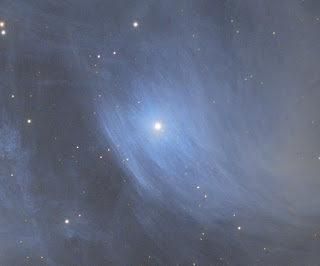One the most recognisable objects in the night sky is the
Pleidies or the 7 sisters. In Greek mythology they were the 7 daughters of the
Titan Atlas & and his wife Pleione. Legend says with the weight of the
world on Atlas’s shoulders he was unable to protect his daughters from the great
hunter Orion, so In order to save them Zeus transformed them into stars placed
them in the heavens away from Orion’s reach.
In reality the cluster contains more than three thousand young hot stars all formed within the last 100 million years with only the brightest visible to the naked eye. The blue nebula that is visible is a cloud of dust these cosmic wanderers are just passing through. My image here was captured over several recent clear nights and is a total of just over 3 hours through my telescope.
20 x 3 minute exposures for each Red, Green & Blue ZWO filters, processed in Pixinsight using the new Blur Exterminator plug in.
The Merope Nebula is the brightest
reflection nebula in the Pleiades cluster.
It is also known as Tempel’s Nebula. It was discovered by the German astronomer
Wilhelm Tempel from Venice, Italy on October 19, 1859. Tempel used a 4-inch
refractor to observe the famous open cluster.






No comments:
Post a Comment